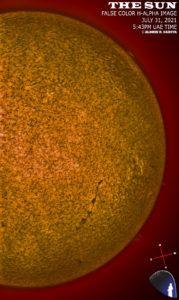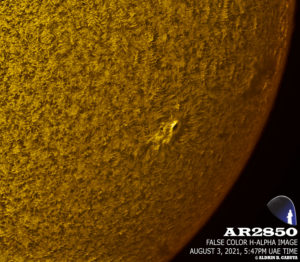The sky was generally clear with intermittent moderate winds which provided good transparency and average seeing at the time these images were taken.
Solar activity remains at very low levels over the past 24 hours. No sunspot groups were visible at this moment. No significant flaring activity was recorded. The latest sunspot number (based on visual count and Wolf number calculation) is 0. The Sun only exhibited a small quiescent prominence at the northeastern limb and a moderately huge eruptive one at the northwestern limb, which is all minor and non-Earth directed, as distinctively captured in H-alpha imagery.
Space weather agencies* forecast solar activity to remain at very low levels with chances of weak X-ray fluxes or flares ranging up to B-class intensity. Close monitoring is being conducted by numerous space weather agencies for any significant development.
Equipment used are Skywatcher 120mm refractor telescope with Baader filter and unmodified Canon EOS 1D Mark IV DSLR camera for visible imagery and Lunt H-alpha solar telescope and QHYCCDIII mono camera for H-alpha imagery, mounted on Skywatcher EQ6 Pro. Pre-processing of visible solar images was performed in PIPP, stacking in Autostakkert, slight wavelet adjustments in Registax 6 and post-processing in Adobe Photoshop CC.
*TECHNICAL REPORTS COURTESY OF SOLAR INFLUENCE DATA CENTER (SIDC), NOAA-SPACE WEATHER PREDICTION CENTER (NOAA-SWPC)
Weather Data (4:40 PM – 5:00 PM, February 15, 2020, from NCM Al Wathba Station):
Average Temperature: 22.95°C
Average Humidity: 52%
Average Wind Speed and Direction: 16.6 kph from NNW
Average Cloud Cover: 0%
Average Air Pressure: 1007.6 hpa
Average Solar Radiation: 242 W/m^2
Average UV Radiation: — µW/m^2








